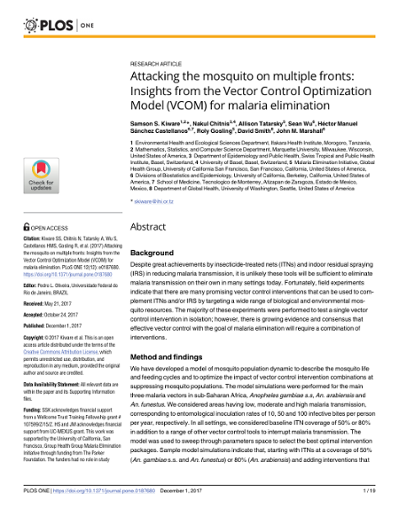| dc.creator | Héctor Manuel Sánchez Castellanos | |
| dc.date | 2017 | |
| dc.date.accessioned | 2018-10-18T21:51:01Z | |
| dc.date.available | 2018-10-18T21:51:01Z | |
| dc.identifier.issn | 19326203 | |
| dc.identifier.doi | 10.1371/journal.pone.0187680 | |
| dc.identifier.uri | http://hdl.handle.net/11285/630489 | |
| dc.description | Background: Despite great achievements by insecticide-treated nets (ITNs) and indoor residual spraying (IRS) in reducing malaria transmission, it is unlikely these tools will be sufficient to eliminate malaria transmission on their own in many settings today. Fortunately, field experiments indicate that there are many promising vector control interventions that can be used to complement ITNs and/or IRS by targeting a wide range of biological and environmental mosquito resources. The majority of these experiments were performed to test a single vector control intervention in isolation; however, there is growing evidence and consensus that effective vector control with the goal of malaria elimination will require a combination of interventions. Method and findings: We have developed a model of mosquito population dynamic to describe the mosquito life and feeding cycles and to optimize the impact of vector control intervention combinations at suppressing mosquito populations. The model simulations were performed for the main three malaria vectors in sub-Saharan Africa, Anopheles gambiae s.s, An. arabiensis and An. funestus. We considered areas having low, moderate and high malaria transmission, corresponding to entomological inoculation rates of 10, 50 and 100 infective bites per person per year, respectively. In all settings, we considered baseline ITN coverage of 50% or 80% in addition to a range of other vector control tools to interrupt malaria transmission. The model was used to sweep through parameters space to select the best optimal intervention packages. Sample model simulations indicate that, starting with ITNs at a coverage of 50% (An. gambiae s.s. and An. funestus) or 80% (An. arabiensis) and adding interventions that do not require human participation (e.g. larviciding at 80% coverage, endectocide treated cattle at 50% coverage and attractive toxic sugar baits at 50% coverage) may be sufficient to suppress all the three species to an extent required to achieve local malaria elimination. Conclusion: The Vector Control Optimization Model (VCOM) is a computational tool to predict the impact of combined vector control interventions at the mosquito population level in a range of eco-epidemiological settings. The model predicts specific combinations of vector control tools to achieve local malaria elimination in a range of eco-epidemiological settings and can assist researchers and program decision-makers on the design of experimental or operational research to test vector control interventions. A corresponding graphical user interface is available for national malaria control programs and other end users. © 2017 Kiware et al. This is an open access article distributed under the terms of the Creative Commons Attribution License, which permits unrestricted use, distribution, and reproduction in any medium, provided the original author and source are credited. | |
| dc.language | eng | |
| dc.publisher | Public Library of Science | |
| dc.relation | https://www.scopus.com/inward/record.uri?eid=2-s2.0-85036657978&doi=10.1371%2fjournal.pone.0187680&partnerID=40&md5=3709e110ac0404d45e4a72c5d01ced2a | |
| dc.relation | Investigadores | |
| dc.relation | Estudiantes | |
| dc.rights | info:eu-repo/semantics/openAccess | |
| dc.rights.uri | http://creativecommons.org/licenses/by-nc-nd/4.0 | |
| dc.source | PLoS ONE | |
| dc.subject | larvicidal agent | |
| dc.subject | Africa south of the Sahara | |
| dc.subject | Anopheles arabiensis | |
| dc.subject | Anopheles funestus | |
| dc.subject | Anopheles gambiae | |
| dc.subject | Article | |
| dc.subject | bovine | |
| dc.subject | disease transmission | |
| dc.subject | feeding behavior | |
| dc.subject | inoculation | |
| dc.subject | insect bite | |
| dc.subject | life cycle | |
| dc.subject | malaria | |
| dc.subject | model | |
| dc.subject | mosquito control | |
| dc.subject | population dynamics | |
| dc.subject | prediction | |
| dc.subject | simulation | |
| dc.subject | vector control | |
| dc.subject | zoology | |
| dc.subject | animal | |
| dc.subject | Anopheles | |
| dc.subject | ecosystem | |
| dc.subject | malaria | |
| dc.subject | mosquito control | |
| dc.subject | mosquito vector | |
| dc.subject | physiology | |
| dc.subject | procedures | |
| dc.subject | sexual behavior | |
| dc.subject | Animals | |
| dc.subject | Anopheles | |
| dc.subject | Ecosystem | |
| dc.subject | Malaria | |
| dc.subject | Mosquito Control | |
| dc.subject | Mosquito Vectors | |
| dc.subject | Sexual Behavior, Animal | |
| dc.subject.classification | 7 INGENIERÍA Y TECNOLOGÍA | |
| dc.title | Attacking the mosquito on multiple fronts: Insights from the Vector Control Optimization Model (VCOM) for malaria elimination | |
| dc.type | Artículo | |
| dc.identifier.volume | 12 | |
| dc.identifier.issue | 12 | |
| refterms.dateFOA | 2018-10-18T21:51:01Z | |




